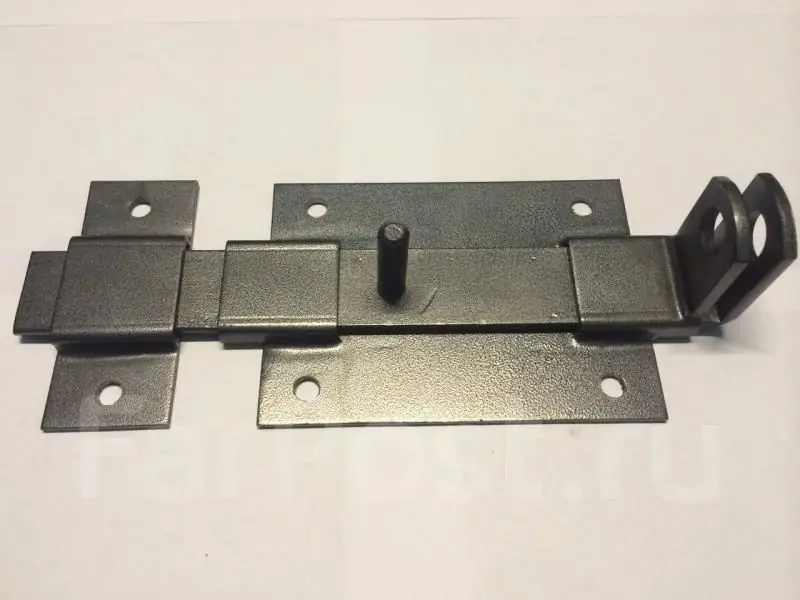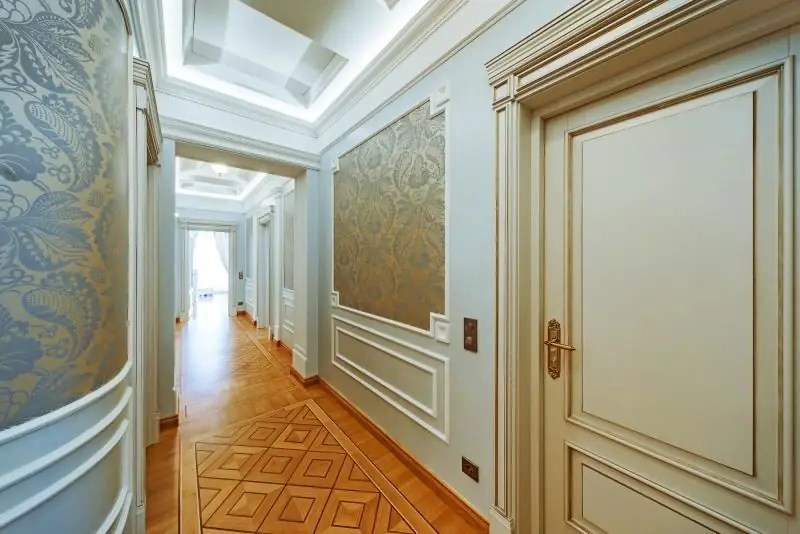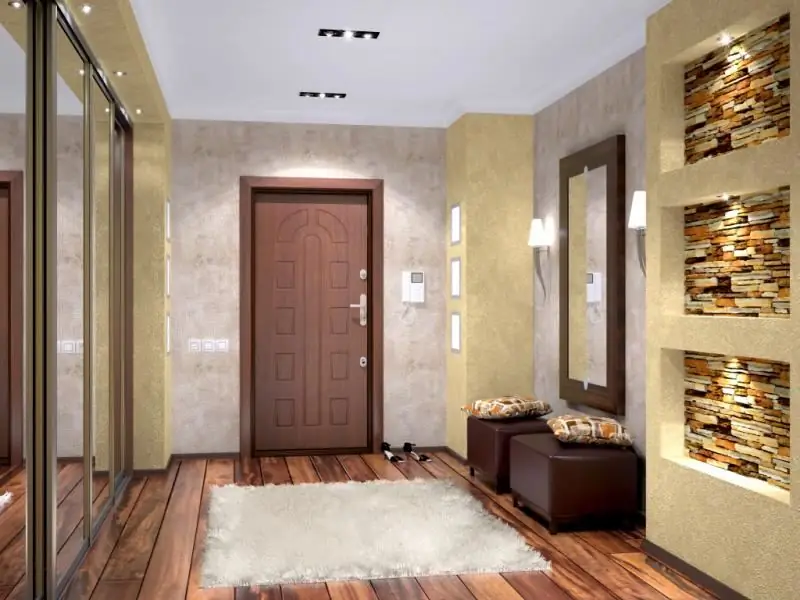
Table of contents:
- Author Bailey Albertson [email protected].
- Public 2023-12-17 12:53.
- Last modified 2025-01-23 12:41.
Types of door latches and features of their installation

If the lock is an obligatory element of the fittings for the front door, then it is rarely installed on the interior structures. To ensure the ability to close the door and prevent access to the room, a latch is usually installed. Depending on the type of locking mechanism used, the doors can only be fixed in the closed position or locked and restrict access to the room. Such structures can be installed both on interior doors and on gates, in office, industrial and other premises.
Content
-
1 Device and purpose of the door latch
1.1 Features of choice
-
2 Types of door latches
2.1 Video: overview of magnetic latches
-
3 Installing door strikes
- 3.1 Video: Installing the door latch
-
3.2 Features of installation on doors made of various materials
3.2.1 Video: ball latch on a metal wicket
- 3.3 How to disassemble a door latch
- 4 Reviews
The device and purpose of the door latch
Modern latches differ in appearance, size and design. Despite this, they all have one purpose - to hold the door leaf in a closed but unlocked position. Some models of latches have a latch that allows you to block the doors from the inside, after which access to the room from the outside will be impossible. Such devices are usually installed at the entrance to the bathroom or toilet, but they can be mounted on any other door.

Door latch keeps the leaf in a closed position
The latch allows you to securely fix the door leaf in the closed position. This is true, for example, when a door separates a heated and unheated room and it is necessary to keep the house warm. Extraneous noise will not penetrate through tightly closed doors. If the room has an air conditioner, then for its effective operation in the summer, it is also necessary that the door be closed.
In the event of a draft, the door leaf can open abruptly and injure a child or even an adult. The presence of a latch on it allows you to securely fix the doors, so this possibility will be completely excluded.
A high-quality door latch should have the following characteristics:
- reliable fixation of the blade in the closed position. It should not open from a draft or light touching the door;
- noiselessness. When the locking device is in operation, there should be no loud clicks;
- uninterrupted work. The mechanism must work reliably and not break, therefore it is necessary to choose devices designed for the maximum number of working cycles.
Selection features
There are different types of door strikes. Depending on the model and type, they can consist of the following components:
- body;
- a pen;
- retainer;
- crossbar - magnetic, ball or in the form of an oblique tongue;
-
return device. It can be an ordinary spring or a more complex mechanism powered by an electrical network.

Door latch device Depending on the type of door latch, its device may vary slightly
Modern door latches are classified according to several criteria:
-
Mechanism type:
- magnetic, halyard or roller. Such valves are usually installed on interior doors;
- sliding - installed at the entrance to a house, apartment, office;
- electromechanical or electromagnetic - they are mounted on gates, entrances to the entrance of a house or on the doors of protected objects.
-
Installation method:
-
mortise. They are installed inside the door leaf, therefore they remain practically invisible. The disadvantage of this solution is in a more complex installation;

Mortise latch The mortise latch is inserted into the end of the door leaf
-
waybills. Although these latches are easier and faster to install, they don't look very attractive, so they are rarely used.

Surface mounted latch Surface-mounted latch is fixed directly to the door
-
-
Availability of additional functions:
-
retainer. Such devices are usually installed on the entrance doors to the bathroom, toilet or other premises, where it is necessary not only to fix the canvas, but also to block the access of unauthorized persons;

Latch with lock Latch with latch allows you to lock doors from the inside
-
lock. The presence of the lock allows you to ensure the protection of the premises from the penetration of unauthorized persons. Such models are usually used on doors in offices or other areas with a small degree of secrecy.

Key latch Key latch allows you to lock doors both from the inside and from the outside
-
Among the advantages of door latches, it should be noted:
- simplicity of design;
- the convenience of use;
- long service life;
- reliable fixation of the door leaf in the closed position, which allows ensuring heat and sound insulation of the room.
There are practically no serious flaws in such devices. Its main disadvantages:
- some models, when the tongue hits the counter part, emit a loud click, which can create some inconvenience;
- with prolonged use of such accessories, scratches and grooves remain on the striker plate, which spoils its appearance.
Types of door latches
Let's take a closer look at each type of door latch:
-
Fale. In order to close the door with the latch latch, it is necessary to apply a certain force, at which the beveled tongue will slide along the striker and snap into place, fixing the door leaf. If such a device is correctly installed, then it will be possible to open the door only after pressing the handle or turning the key. Handles can only be installed on one side of the door or both. The latch latches can be equipped with two locks: one opens with a handle, and the second is independent and works as a latch. The handles of such mechanisms fulfill not only their direct purpose, but also decorate the doors, so they must correspond to the interior of the room.

Fale latch The latch has a beveled tongue
-
Roller. In this case, a rotating roller or tongue, beveled on both sides, acts as a bolt. Such a latch can be placed both on the door leaf and on the box. When the door is closed, a spring-loaded roller enters the hole in the striker and secures the sash in the closed position. The roller latch can be installed as a separate device or work as part of a lock on both swing and pendulum leaves. It is not connected to the handle or other locking bolts on the lock. It will not be possible to fully close the door using the roller latch, since when you press on it with a certain effort, it will open.

Roller latch Roller latches usually have a rotating roller as a bolt
-
Magnetic. The principle of operation of such devices is based on the property of a magnet to attract metal parts. Magnetic strikes are often used in both residential and office environments. They allow the sash to be locked in the closed position, and it takes little effort to open it. One part of such a device is fixed at the end of the canvas, and the other - on the door frame. After the door has closed, the magnet is attracted to the metal striker plate and the leaf fixes the door in the closed position. There are simple models that are similar to those found on furniture, only with a greater pull. Some modifications of magnetic latches have a deadbolt that retracts into the hole in the counterpart. Opening such a latch can only be done with a rotary or lever handle.

Magnetic latch The work of the magnetic latch is based on the property of a magnet to attract metal objects
-
Sliding. In this case, the developers have combined the functions of a lock and a latch in one device. Such devices do not have a handle, so they can be opened from the inside with a pinwheel or from the outside with a key. Almost all of these models have a retainer, which, if necessary, allows you to hide the spring-loaded bolt in the latch body. When it is hidden and locked, spontaneous closing of the mechanism is excluded, but in this case the door will not be fixed in the closed position and can open at any time.

Sliding latch Sliding latch can only be opened with a handle, some models can be opened with a key
-
Electromechanical and electromagnetic. Such devices allow you to remotely close and open doors, therefore they are usually installed on gates or at the entrances to protected premises. For electromagnetic devices, it is necessary to additionally install an autonomous power supply. This is due to the fact that in the absence of power supply, they are in an open state. There are the following types of latches:
-
normally open. When the power is turned off, these latches are in the open position. They are usually installed at emergency exits as well as driveways. In the event of an emergency, when a power outage occurs, people can safely leave the premises;

Normally open latch In the absence of power, the normally open latch is in the open state
-
normally closed. In the absence of electricity, such latches are in the closed position. This allows you to ensure the safety of the premises in the event of a power failure. In such cases, you can open the latch from the inside with a handle, and from the outside with a key;

Normally closed latch Latch is in closed position when no voltage is applied
- with locking function. When voltage is applied, the latch is unlocked and remains in this position until the door is opened once. After the tongue is pulled into the body, it is fixed there with special pins and can be held at any time until the door is used.
-
Video: overview of magnetic latches
Installing door latches
If you have basic carpentry skills, even a beginner will not have problems with installing a latch on an interior door. To install such a device, you will need the following tools:
- electric drill;
- set of drills;
- set of screwdrivers;
- screwdriver;
- a hammer;
- chisel;
- milling cutter;
- knife;
- corner;
- ruler;
- roulette;
-
pencil.

Latch Installation Tools You will need hand and power tools to mount the latch.
The installation process of the mortise latch consists of the following stages:
-
Choice of installation height. For ease of use and to ensure good fixation of the canvas, it is recommended to install door latches at a height of 80 to 110 cm - it all depends on the height of the residents.

Latch installation height It is recommended to install door latches at a height of 80 to 110 cm, depending on the height of the residents
-
Door leaf markings. At a previously determined height, the location of the latch is noted, after which it is applied to the end of the door and outlined with a pencil. If the device has a handle, then on both sides of the canvas mark the places where it will be installed.

Door leaf markings A latch is applied to the end of the door and the place of its installation is marked
-
Hole preparation. Holes of the required depth are drilled at the end of the door inside the marked contour using a drill. After that, level it using a chisel and a hammer. They also make a hole for attaching the handle. If you have a router, then this work is done easier and faster. To prevent chipping, holes for the handle are drilled on both sides of the door so that the drill extends approximately half the thickness of the door leaf.

Hole preparation Drill holes for installing the latch and handle
-
Preparing a place for a latch strip. Check if the mechanism fits into the prepared hole. If not, then the niche is slightly expanded with a hammer and chisel. After that, insert the latch into the prepared groove and draw a pencil around its overlay. Pull out the device and make a small recess so that the latch bar is flush with the end of the door.

Preparing a place for a latch strip With the help of a chisel and a hammer, recesses are made for mounting the latch strip
-
Installation of the latch. Install the latch in the prepared place and fix it with self-tapping screws. To make the screws easier to screw in and not lick their heads, experts recommend pre-making holes for them with a thin drill. If the latch has a handle, then insert a four-sided pin, put the handles on it and fix them, and then mount the decorative overlays.

Latch mounting The latch is fixed with self-tapping screws, having previously made holes for them with a thin drill
-
Mounting the counter part. In order to accurately determine the location of the striker on the door frame, you need to grease the tongue with toothpaste and close the doors. A trace will remain on the frame, to which the counterpart is applied and the place of its attachment is marked. Using a hammer and a chisel, a recess for the tongue is prepared on the frame and the striker is fixed.

Mounting the mounting plate The striker is mounted on the frame opposite the latch
Installation of the cover plate is much easier and faster:
- Markup. On the door leaf, mark the location of the latch and prepare the places for the screws.
- Installation of the latch. A locking mechanism is screwed onto the prepared place.
-
Mounting the counter part. Opposite the installed latch, the counterpart is screwed to the door frame. It is also recommended here to pre-drill holes for self-tapping screws.

Installation of the surface latch Usually, an overhead latch is fixed to the canvas, and the counterpart is fixed to the frame.
Video: installing a door latch
Features of installation on doors made of various materials
Depending on the material and design of the door, the latch can be installed in different ways:
- There are no problems with installing a latch in doors made of solid wood. Here, the canvas is entirely made of wood, so you can install such a device in any convenient place.
- If a frame door is installed, which is sheathed with plywood, fiberboard or similar material, it is better to install the mortise latch in the place where the horizontal bars are located. In standard designs, they are at a height of 1 m. If the door is homemade, then you must first determine the location of the bars.
- The same applies to the situation when installation in plastic doors is planned. Here it is also possible to carry out installation of mortise structures only at the locations of the stiffeners.
-
Installing a latch on a metal door or wicket is a little more complicated. This is due to the fact that metal is much harder than wood and you may need a welding machine to work with it. Otherwise, the sequence of work is the same as for wooden doors.

Installation of a latch on a metal wicket You may need a welding machine to mount the latch on metal doors.
Video: ball latch on a metal gate
How to disassemble a door latch
Sometimes it becomes necessary to disassemble the door latch. This may be required when:
- there is a creak or jamming during the operation of the mechanism;
- it is necessary to lubricate and clean the locking device;
- it is necessary to change the failed parts;
- it was decided to completely replace the latch.
Depending on the type of latch installed, the sequence of work may differ slightly. The procedure for disassembling a mechanism equipped with a push or rotary handle will be as follows:
-
Remove decorative handles. Depending on the model, pry them off with a sharp object or unscrew the fixing screw.

Removing the decorative handles To remove the decorative overlays, you need to unscrew the screws, in some models it is enough to pry them with a screwdriver
- Dismantle the handles. Unscrew the screws securing the handles. After that, remove both handles and pull out the quadrangular pin.
-
Remove the latch mechanism. At the end of the leaf, the fasteners are unscrewed and the latch is removed from the door.

Removing the latch Unscrew the mount and remove the latch
After that, the reasons that led to the failure of the latch are established:
- if creaking and jamming appeared as a result of lack of lubrication and dust ingress, then the mechanism is cleaned and lubricated;
- when rust forms, it is removed and the latch is treated with a liquid with anti-corrosion properties;
- if a spring or tongue breaks, they are replaced with new parts;
-
if the mechanism is completely worn out, it is necessary to install a new latch.

Disassembling the latch Remove the latch body, find out the cause of the breakdown and eliminate it
Reviews
It is not difficult to install the door latch yourself. To do this, you need to have basic skills in performing carpentry work, as well as a set of necessary tools. First, they are determined with the requirements that apply to the latch. After that, choose a model with or without a handle, with or without the possibility of locking the door. Performing installation in accordance with the developed technologies, you can simply and quickly install the latch, which will reliably fix the door leaf and work trouble-free for many years.
Recommended:
Door Latch (latch): Varieties With Description And Characteristics, Pros And Cons, As Well As How To Properly Install On The Door

The purpose of the door latch. Principle of operation. Types of door valves. Installation of various types of valves. Features of installation on different types of doors
Platbands On The Door: Varieties With A Description And Characteristics, Pros And Cons, And How To Install Correctly

Why do we need door trims and how they can be beaten in the interior. How to do it yourself from wood, plywood and plaster. We study materials and make a choice
Door Opening Limiter: Varieties With Description And Characteristics, Pros And Cons, And How To Install Correctly

A variety of door stops, their differences in type of construction and installation method. DIY installation and repair of door stops
Front Door Trim: Varieties With Description And Characteristics, Pros And Cons, And How To Install Correctly

Appointment of overlays on the front door. Their description, features, advantages and disadvantages. Do-it-yourself technology for installing linings on front doors
Toilet Roller Shutters: Varieties And Material, Pros And Cons, As Well As How To Properly Install And Operate

Appointment of roller shutters in the toilet. Types and dimensions of roller shutters. Assembly and installation process. Features of repair and operation of roller shutters
